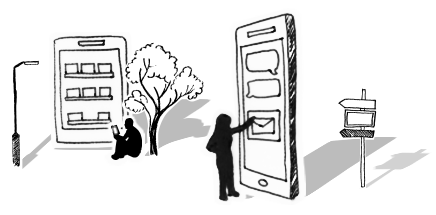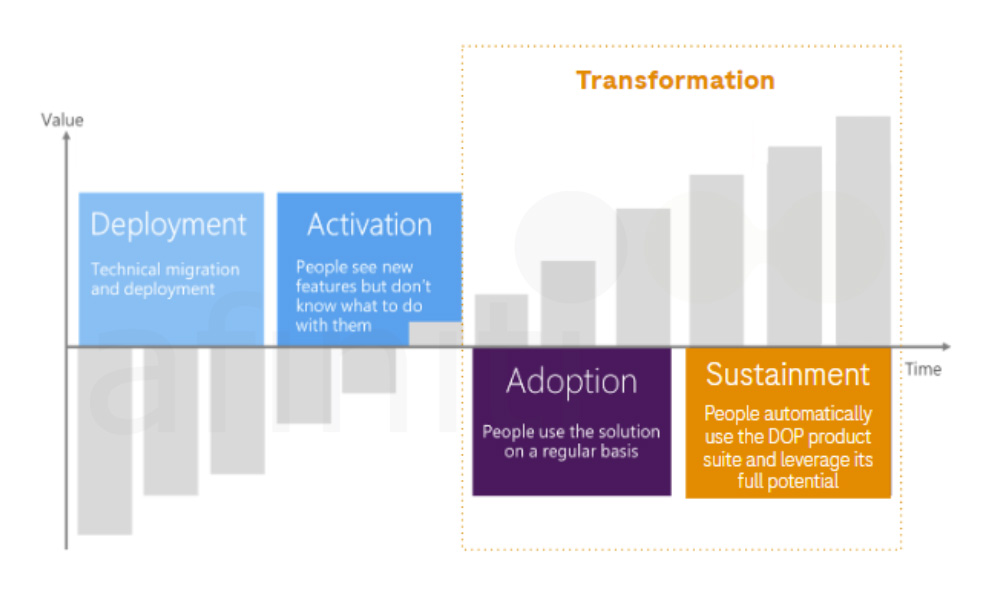




How to Prove Your Strategic Value
The whole may be greater than the sum of its parts, but that doesn’t mean the individual parts don’t need to shine. This is especially true during change, when specific functions will have specific goals around people, process and tools that will all contribute to the wider business transformation.
For change programmes to land successfully, functional teams need to be aligned on and work towards one set of strategic enterprise-wide goals: the vision’s ‘North Star.’ When individual functions can see how their specific objectives relate and deliver into the enterprise strategy, they can better articulate their functional roadmap, see progress and demonstrate value to key stakeholders. Doing so enables them to work in partnership with cross-functional leadership, amplifying business benefits.
That’s where the value proposition comes in. This insight will explore ways in which functional leaders can clearly convey the strategic value their teams add to supporting the company vision, how to align with the wider business and how to bring this all to life through compelling, impactful, data-driven value propositions and engagement strategies that will support those ultimately realising the change: your people.
Do individual functions need their own value propositions?
In short – Yes? A true business-driven value proposition serves several important purposes:
At your leadership level: The value proposition equips leaders to understand the function’s objectives and, crucially, how these connect to the wider organisational strategy. This helps to establish cross-functional partnerships working towards common strategic goals.
At your workforce level: Engaging your people with a strong value proposition will allow them to connect their day-to-day work into the broader business mission, cultivating a change-receptive ‘one-company’ culture. This also lowers the risk of disconnected silos working towards different goals, which can impede change adoption and benefits realisation.
At your internal customer level: Functions that provide critical support to other areas of the business need to be able to communicate the value of the services they provide to maximise utilisation, introduce new processes and optimise investments to achieve the desired strategic outcomes.
How to realise strategic value through communication
Afiniti partners with clients by helping them to clearly articulate the purpose and value of their strategy and business case. These engagement strategies are targeted and coordinated, and there are a variety of people change interventions that can be utilised. Here are the ones that I believe have had the greatest impact:
A formal value proposition
The core essence of the value proposition is to articulate the purpose of the work a function does to support an organisation and its strategic goals and the value that this adds.
My recommendation: Create a comprehensive and visually impactful playbook to present the function’s value proposition, a key asset for engaging other departments and impacted stakeholders.
A clear and compelling narrative
Stories are a fantastic way to engage people, and a compelling narrative can position your value proposition in the context of your change and strategic vision, making it relatable to the business at multiple levels.
My recommendation: Build a key message framework defining the most important elements of your narrative and how these should be articulated. This will help sponsors to be consistent in their messaging of your vision and benefits.
Equip your leaders
Executives need to be able to share their strategic ambitions with cross-functional leaders to gain sponsorship for change and drive cohesive action. Ensure leaders are active, visible and aligned with the value proposition and have the assets needed to communicate this.
My recommendation: Feature leaders in the communications strategy so they can directly tell the story, through video, podcasts and forums. Providing gravitas, they make the change more relatable and people-focused, helping to bring it to life.
Establish an identity
Your function needs to stand out to be recognised, and therefore your engagement strategy needs a distinct identity. This should creatively present the key attributes of the function, your tone and how you want to be perceived, capturing your unique value to the overall organisation.
My recommendation: We co-create with the team representatives to create a visual identity complements your corporate brand while setting you apart with message-rich visuals to tell your individual story. Make engagement assets visual and impactful, for example, infographics or rich pictures that can help explain a complex concept.
Know your audience
It’s really important to know the customers of your work and the leaders you need to align with most to best position your value proposition, as they will all have different engagement opportunities and communications preferences.
My recommendation: Conduct stakeholder analysis and interviews to directly ascertain what information different stakeholder groups will respond best to, so you can build this into your engagement strategy.
The communications plan
Plan a regular cadence of creative communications that will clearly demonstrate the function’s value, address any blockers and promote any necessary calls to action for achieving your objectives.
My recommendation: Encourage people from across your team and other functions to get involved in creating communications. This makes them more authentic, compels people to engage with them and ultimately enhances change adoption.
Share success stories
If you’re communicating value, then sharing success stories is obviously an excellent tactic to do so. Examples bring your work to life, showing real people delivering real value.
My recommendation: Don’t expect people to find these stories themselves – you need your teams to shout loudly about the success and share the value that is being delivered in achieving the organisational goals.
Create advocates
The people working within a function should be its biggest advocates. If they are aligned to the direction of your goals, they will organically express the value they bring just by carrying out their day-to-day work. Conversely, confusion about their value leads to siloes, lack of morale and inefficiency.
My recommendation: Change networks should be established to support engagement; encourage your people to build their networks, especially where they have direct access to key stakeholders.
The strategic value proposition in action
Crafting a compelling functional value proposition was key to an award-winning and cutting-edge digital transformation that we recently supported.
The Clinical Science function of our global life sciences client is responsible for the Protocol, a 200+ page living document considered ‘the bible’ of any clinical study. They sought to digitalise all existing Protocols to inform the creation of future ones, unlocking the ability to drive multimillions of cost and time improvements. Afiniti partnered with Clinical Science to support the rollout and adoption of the new tool to do so.

This had to engage multiple, diverse, siloed functions into trusting and collaboratively using the new first-gen AI tool and its data insights. Therefore, we engaged directly with users about how they have seen value from the tool, which generated further interest. We spoke with our top users every month to understand their experiences and portrayed these on TV screens, posters and an interactive dashboard.
This was a coordinated effort to engage from within via the client’s biggest active change champions network – a global community of subject matter experts – aiming to articulate user needs to inform design and create an organic, business-led ‘movement’, which grew exponentially as more colleagues understood the value of the Digitalisation team.
Once the new system had proved its effectiveness, it gained permanent sponsors. We utilised this support to further build out the team’s value proposition. Supporting artefacts included video interviews with sponsors highlighting success and sharing a future vision.
Growing our support network was critical as it became clear that the initiative was delivering value and would therefore need to scale benefits across the organisation. Our enterprise-wide engagement looked at the end-to-end study design lifecycle and where digitalisation could add value, give greater clinical insights and save time for development teams. This galvanised many senior leaders and enabled them to drive our narrative far and wide.
The benefits of independent insight
Articulating your function’s value can be complex, and it’s difficult to recover from if executed poorly or maybe not at all. This is where an independent specialist can support; they can bring data-backed insights, rich experience and objective analysis to help you identify, construct and communicate your strategic value.
So, if you’d like to learn more about the crucial role of articulating value in achieving functional and enterprise-level change, get in touch with our team. We’d be happy to discuss how we can help.
To get the latest change tips, advice and guidance directly to your inbox, sign up to our monthly Business Change Digest.

